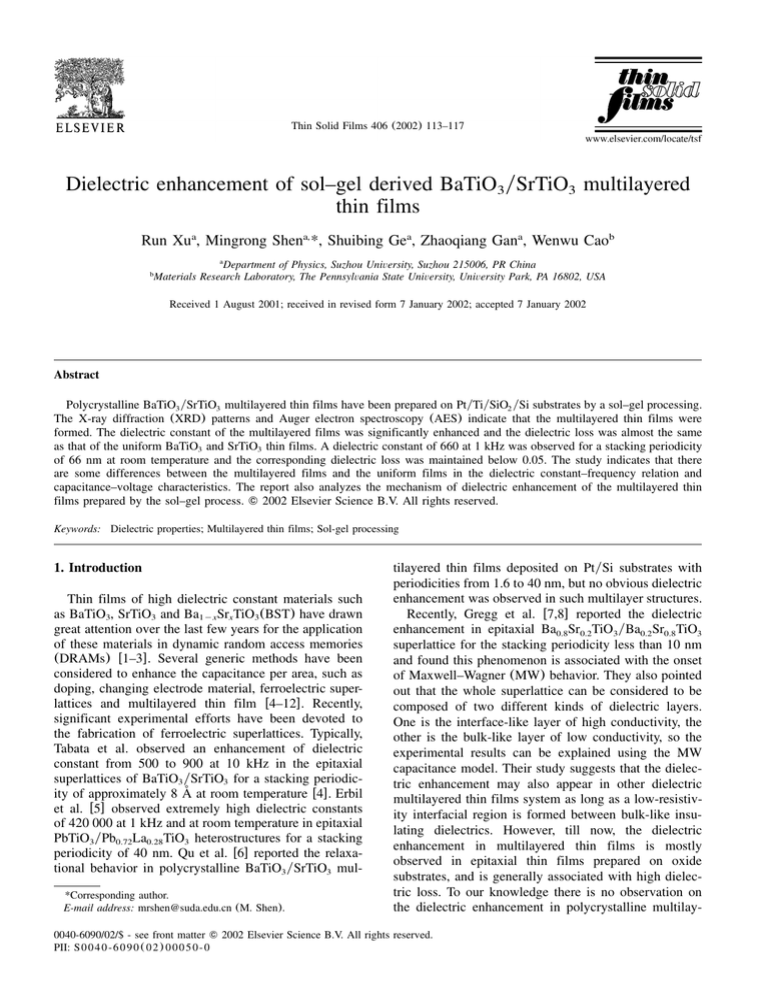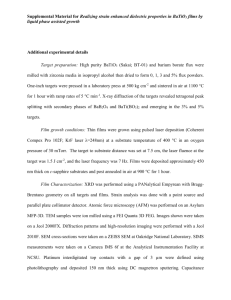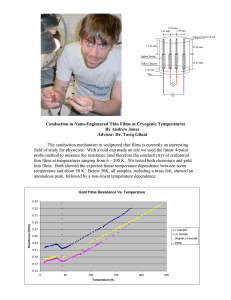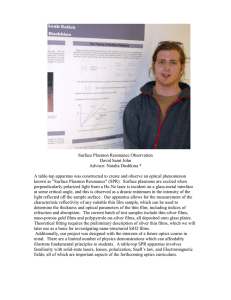
Thin Solid Films 406 (2002) 113–117
Dielectric enhancement of sol–gel derived BaTiO3 ySrTiO3 multilayered
thin films
Run Xua, Mingrong Shena,*, Shuibing Gea, Zhaoqiang Gana, Wenwu Caob
a
Department of Physics, Suzhou University, Suzhou 215006, PR China
Materials Research Laboratory, The Pennsylvania State University, University Park, PA 16802, USA
b
Received 1 August 2001; received in revised form 7 January 2002; accepted 7 January 2002
Abstract
Polycrystalline BaTiO3 ySrTiO3 multilayered thin films have been prepared on PtyTiySiO2 ySi substrates by a sol–gel processing.
The X-ray diffraction (XRD) patterns and Auger electron spectroscopy (AES) indicate that the multilayered thin films were
formed. The dielectric constant of the multilayered films was significantly enhanced and the dielectric loss was almost the same
as that of the uniform BaTiO3 and SrTiO3 thin films. A dielectric constant of 660 at 1 kHz was observed for a stacking periodicity
of 66 nm at room temperature and the corresponding dielectric loss was maintained below 0.05. The study indicates that there
are some differences between the multilayered films and the uniform films in the dielectric constant–frequency relation and
capacitance–voltage characteristics. The report also analyzes the mechanism of dielectric enhancement of the multilayered thin
films prepared by the sol–gel process. 䊚 2002 Elsevier Science B.V. All rights reserved.
Keywords: Dielectric properties; Multilayered thin films; Sol-gel processing
1. Introduction
Thin films of high dielectric constant materials such
as BaTiO3, SrTiO3 and Ba1yxSrxTiO3(BST) have drawn
great attention over the last few years for the application
of these materials in dynamic random access memories
(DRAMs) w1–3x. Several generic methods have been
considered to enhance the capacitance per area, such as
doping, changing electrode material, ferroelectric superlattices and multilayered thin film w4–12x. Recently,
significant experimental efforts have been devoted to
the fabrication of ferroelectric superlattices. Typically,
Tabata et al. observed an enhancement of dielectric
constant from 500 to 900 at 10 kHz in the epitaxial
superlattices of BaTiO3 ySrTiO3 for a stacking periodic˚ at room temperature w4x. Erbil
ity of approximately 8 A
et al. w5x observed extremely high dielectric constants
of 420 000 at 1 kHz and at room temperature in epitaxial
PbTiO3 yPb0.72La0.28TiO3 heterostructures for a stacking
periodicity of 40 nm. Qu et al. w6x reported the relaxational behavior in polycrystalline BaTiO3 ySrTiO3 mul*Corresponding author.
E-mail address: mrshen@suda.edu.cn (M. Shen).
tilayered thin films deposited on PtySi substrates with
periodicities from 1.6 to 40 nm, but no obvious dielectric
enhancement was observed in such multilayer structures.
Recently, Gregg et al. w7,8x reported the dielectric
enhancement in epitaxial Ba0.8Sr0.2TiO3 yBa0.2Sr0.8TiO3
superlattice for the stacking periodicity less than 10 nm
and found this phenomenon is associated with the onset
of Maxwell–Wagner (MW) behavior. They also pointed
out that the whole superlattice can be considered to be
composed of two different kinds of dielectric layers.
One is the interface-like layer of high conductivity, the
other is the bulk-like layer of low conductivity, so the
experimental results can be explained using the MW
capacitance model. Their study suggests that the dielectric enhancement may also appear in other dielectric
multilayered thin films system as long as a low-resistivity interfacial region is formed between bulk-like insulating dielectrics. However, till now, the dielectric
enhancement in multilayered thin films is mostly
observed in epitaxial thin films prepared on oxide
substrates, and is generally associated with high dielectric loss. To our knowledge there is no observation on
the dielectric enhancement in polycrystalline multilay-
0040-6090/02/$ - see front matter 䊚 2002 Elsevier Science B.V. All rights reserved.
PII: S 0 0 4 0 - 6 0 9 0 Ž 0 2 . 0 0 0 5 0 - 0
114
R. Xu et al. / Thin Solid Films 406 (2002) 113–117
ered thin films deposited on Si substrates, which are
more compatible with large-scale integration than oxide
substrates. In this paper, we report on the dielectric
enhancement in polycrystalline BaTiO3 ySrTiO3 multilayered thin films prepared on PtyTiySiO2 ySi substrates
by sol–gel processing.
2. Experimental details
To produce the multilayered BaTiO3 ySrTiO3 films,
two solutions were prepared for deposition by spincoating. The raw materials for the solution synthesis
were barium acetate wBa(CH3COO)2 x, strontium acetate
wSr(CH3COO)2 x,
and
titanium
butoxide
wTi(OC4H9yn)4x. Glacial acetic acid (CH3COOH) and
methanol (CH3OH) may be a stabilizer and solvent,
respectively. Barium acetate or strontium acetate was
dissolved into heated acetic acid. The solutions were
then mixed and stirred. The equimolar amounts of
titanium butoxide were added into the mixture and then
the mixture was stabilized by appropriate methanol. The
clear yellowish solution was finally prepared. The solutions in sealed bottles are stable and no crystallite forms
for several months. The concentration of the final
solution can be adjusted to 0.2 molyl by adding appropriate quantity of solvent. The whole process of the
preparation of the precursor solution was prepared in an
ambient atmosphere.
Spin-coating was employed to deposit the filtered
solution (syringe filters with 0.1 mm pore diameter) at
4500 rpm for 40 s onto the PtyTiySiO2 ySi substrates.
The wet films were pyrolyzed at 120 8C for 2 min just
after deposition and then annealed at 750 8C for 8 min.
The films were obtained by multiple repetitions of the
deposition. In this work, all the films were 396"6 nm
thick, with a deposition of 12 layers. We prepared two
multilayered thin films with different periodicity. The
periodicity of sample A is 66 nm, which indicates the
thickness of each BaTiO3 layer or SrTiO3 layer is 33
nm. The periodicity of sample B is 132 nm, and the
thickness of each BaTiO3 layer or each SrTiO3 layer is
66 nm. The bottom layer of all the multilayered films
is BaTiO3 and the top layer is SrTiO3. As references,
the uniform films of BaTiO3 and SrTiO3 with same
thickness were also prepared under the same conditions.
It can be noted that all the films experience the same
total time for heat treatment at a temperature of 750 8C.
The structure of the film was analyzed by a Rigaku
DyMAX 3C XRD diffractometer using Cuka radiation
at 40 KV. The microstructure of the film was investigated using a Hitachi S-5750 SEM. The electric measurements were performed on the films in
metal–insulate–metal (MIM) configuration. Pt dots of
0.25 mm in diameter were prepared by RF-sputtering
through a mask on the films to form MIM capacitors.
The dielectric constant and loss measurements were
Fig. 1. The XRD patterns of (a) BaTiO3 (33 nm)ySrTiO3 (33 nm),
(b) BaTiO3 (66 nm)ySrTiO3 (66 nm), (c) SrTiO3 and (d) BaTiO3.
carried out with a HP4192A LF impedance analyzer.
The film thickness was determined with an ET350
Talysurf profilometer (Kosaka Laboratory Ltd.) after
selective etching in buffered HF.
3. Results and discussion
Fig. 1 shows the XRD patterns of BaTiO3 ySrTiO3
multilayered thin films. There are many peaks on each
pattern, which indicates that these samples were polycrystalline in nature with a perovskite structure. No
minority phase such as BaCO3, SrCO3 and TiO2 was
observed. The XRD patterns are composed of two sets,
one for BaTiO3, the other for SrTiO3, as is shown in
the XRD patterns of multilayered thin films (Fig. 1a for
the stacking periodicity of 66 nm and Fig. 1b for 132
nm). The result indicates that the phase of BaTiO3 and
SrTiO3 were not diffused together and did not form the
solid solution under the conditions that each layer
annealed at 750 8C for 8 min, but formed the multilayered structure.
Fig. 2 shows the composition depth profile of a
typical BaTiO3 (66 nm)ySrTiO3 (66 nm) film determined by using a combination of AES and Ar ion
etching. The results confirm that the concentration of
Ba and Sr periodically fluctuate with the thickness, and
the molar ratio of (BaqSr)yTiyO is approximately 1:1:3
at any depth. The depth profile also indicates that there
is an apparent interface layer between the BaTiO3 and
SrTiO3 layers.
R. Xu et al. / Thin Solid Films 406 (2002) 113–117
115
Fig. 2. Auger depth profile showing thickness distribution of compositions of a typical BaTiO3 (66 nm)ySrTiO3 (66 nm) film.
The SEM micrographs as shown in Fig. 3, show the
films to be crack-free, and of uniform size grains. The
grain sizes were estimated from the SEM micrographs
using the intercept method, and the grain sizes of
multilayered thin films A and B were approximately 40
nm, and almost the same as that of the uniform SrTiO3
thin film due to the SrTiO3 layer as the top layer. While
the grain size of the uniform BaTiO3 thin film was
approximately 60 nm.
Fig. 4 shows the dielectric constant as a function of
frequency at room temperature. It can be observed that
the dielectric constants of multilayered thin films were
larger than that of uniform thin films. At a frequency of
1 kHz, the dielectric constant of BaTiO3, SrTiO3,
BaTiO3 (33 nm)ySrTiO3 (33 nm), and BaTiO3 (66
nm)ySrTiO3 (66 nm) was 348, 270, 422 and 660,
respectively. The dielectric constant of the uniform
BaTiO3 and SrTiO3 thin films is comparable with that
reported by others w13x for films deposited by the sol–gel
process. We also checked the dielectric constant of the
uniform Ba0.5Sr0.5TiO3 thin films by the same sol–gel
process and found that it is also below 400 in the
frequency range of 100 Hz to 1 MHz. From Fig. 4, it
can be noted that the dielectric constants of all the
examples decrease as the frequency increase, and the
frequency dispersion of the multilayered thin films were
different from that of the uniform films. In the frequency
range of below 109 Hz, the dielectric constant of the
condensed matter as a function of frequency complies
with the following relation w14x:
Fig. 3. The SEM surface micrographs of (a) BaTiO3 (33
nm)ySrTiO3 (33 nm), (b) BaTiO3 (66 nm)ySrTiO3 (66 nm), (c)
SrTiO3 and (d) BaTiO3.
curve at the same time. As shown in Fig. 4, the result
agrees well with the experiment. Obviously, the frequency dispersion of the multilayered thin films was larger
than that of the uniform thin films.
A dielectric constant of 527 at 100 kHz was reported
recently in SrTiO3 yBaTiO3 multilayered thin films w15x,
and explained as the sum of each individual thin films
using a series connection model. However, in our experiment, the dielectric constants of all the uniform thin
films, including SrTiO3, BaTiO3 and Ba0.5Sr0.5TiO3 films
are less than those of the multilayered films. In addition,
we measured the film thickness several times and found
all the films were approximately 396"6 nm in thickness. And all the films showed random crystalline
orientation under present preparation conditions from
´saqbfny1
where the parameters a and b are associated with
temperature, and n is the dispersion parameter, 0-n1. We set the values of n to be 0.961, 0.961, 0.854 and
0.854 in BaTiO3, SrTiO3, BaTiO3 (33 nm)ySrTiO3 (33
nm) and BaTiO3 (66 nm)ySrTiO3 (66 nm), respectively,
and set the appropriate values of a and b to plot a fitting
Fig. 4. The frequency dependence of the dielectric constant of all films
at room temperature.
116
R. Xu et al. / Thin Solid Films 406 (2002) 113–117
Fig. 5. The frequency dependence of the dielectric loss of all the films
at room temperature.
the XRD patterns, which implies that the dielectric
enhancement cannot be attributed to the changes in the
film crystallinity and thickness. In this paper, each layer
was crystallized at 750 8C for 8 min just after deposition,
and then another layer was spin-coated onto the crystallized layer. Thus, the multilayered thin film can easily
be formed by using this procedure, which can be seen
from the XRD and AES results (shown in Figs. 1 and
2, respectively). As proposed by Catalan et al. w8x, space
charges may be produced in the interface layer between
BaTiO3 and SrTiO3, which will lead to the formation of
the special layer of high conductivity, as compared with
the bulk layer of BaTiO3 or SrTiO3 of low conductivity.
The multilayered thin films consisting of two layers
differing in electrical conductivity must give rise to the
dielectric enhancement corresponding to the MW model
w7,8x. Furthermore, the frequency dispersion of multilayered thin films may also be different from that of the
uniform films due to the presence of the interface region.
The dielectric loss–frequency curve at room temperature of the thin film capacitors is shown in Fig. 5. At
10 kHz, the loss tangent of BaTiO3, SrTiO3, BaTiO3
(33 nm)ySrTiO3 (33 nm) and BaTiO3 (66 nm)y
SrTiO3 (66 nm) were 0.0278, 0.0291, 0.0281 and 0.033,
respectively. Dielectric loss increases slightly at the high
and low frequency. The results above show that the loss
tangent of multilayered thin films remained low compared with the uniform thin film, while dielectric constant was enhanced in the sol–gel derived BaTiO3 y
SrTiO3 multilayered thin films on PtyTiySiO2 ySi
substrate. This characteristic of multilayered thin films
was different from that of epitaxial ferroelectric superlattics on oxide substrate. For epitaxial thin film, the
dielectric enhancement is generally associated with high
dielectric loss simultaneously and the stacking periodicity in which the dielectric enhancement can be observed
Fig. 6. The capacitance–voltage curves of (a) BaTiO3 (33 nm)ySrTiO3 (33 nm), (b) BaTiO3 (66 nm)ySrTiO3 (66 nm), (c) SrTiO3 and (d)
BaTiO3 at 500 kHz.
R. Xu et al. / Thin Solid Films 406 (2002) 113–117
is often small (-10 nm). The difference of the interface
of polycrystalline multilayered thin films and epitaxial
ferroelectric superlattics may be attributed to the different phenomenon. The multilayered thin films reported
in this paper were polycrystalline in nature. There were
many grains and grain boundaries in the interface in
each layer. Therefore, it is reasonable to assume that the
thickness of the interface layer is larger than that in
epitaxial dielectric superlattices, which may cause the
larger stacking periodicity required for observing the
dielectric enhancement. And the different nature of the
interface layer may also cause the different characteristic
of the dielectric loss.
Capacitance–voltage (C–V) curves of the films are
shown in Fig. 6. This curve was measured at room
temperature using a small AC signal of 10 mV at 500
kHz. The signal was applied across the sample, while
the d.c. electric field was swept from positive to negative
bias and back again. The C–V curves of BaTiO3 and
BaTiO3 (66 nm)ySrTiO3 (66 nm) films had apparent
hysteresis, while the C–V curves of SrTiO3 and
BaTiO3 (33 nm)ySrTiO3 (33 nm) had no apparent
hysteresis. The C–V curves of SrTiO3 and BaTiO3
indicate the deposited films were paraelectric and ferroelectric in nature, respectively. Due to the presence of
the BaTiO3 ferroelectric layer, the C–V curve of
BaTiO3 (66 nm)ySrTiO3 (66 nm) shows hysteresis. For
BaTiO3 (33 nm)ySrTiO3 (33 nm), the thickness of each
BaTiO3 layer was smaller than the critical size in which
ferroelectricity can be exhibited, so no hystersis can be
observed.
4. Conclusions
Polycrystalline BaTiO3 ySrTiO3 multilayered thin
films have been prepared on PtyTiySiO2 ySi substrates
by sol–gel processing, and compared with the uniform
BaTiO3 and SrTiO3 films. The dielectric constant of the
multilayered films was significantly enhanced and the
dielectric loss was almost the same as that of the uniform
thin films. At 1 kHz, the dielectric constants of
BaTiO3, SrTiO3, BaTiO3 (33 nm)ySrTiO3 (33 nm), and
117
BaTiO3 (66 nm)ySrTiO3 (66 nm) is 348, 270, 422 and
660, and the loss tangents are all below 0.05. The
frequency dispersion of the dielectric constant in the
multilayered thin films is larger than that in the uniform
films, and the capacitance–voltage relation of the multilayered thin films also show different characteristics
with the uniform films. A mechanism of dielectric
enhancement of the sol–gel derived multilayered thin
films was suggested.
Acknowledgments
The authors wish to express their appreciation for the
financial support from the Natural Science Foundation
for youth of Jiangsu, China (grant no. BQ98037).
References
w1x Y. Fukudo, K. Aoki, K. Numata, A. Nishimura, Jpn. J. Appl.
Phys., Part 2 34 (1995) L1291.
w2x O. Auciello, J.F. Scott, R. Ramesh, Phys. Today 51 (1998) 22.
w3x A.I. Kingon, S.K. Streiffer, C. Basceri, S.R. Summerfelt, MRS
Bull. 21 (7) (1998) 2820.
w4x H. Tabata, H. Tanka, T. Kawai, Appl. Phys. Lett. 65 (1994)
1970.
w5x A. Erbil, Y. Kim, R.A. Gerhardt, Phys. Rev. Lett. 77 (1996)
1629.
w6x B.D. Qu, M. Evstigneev, D.J. Johnson, R.H. Prince, Appl.
Phys. Lett. 72 (1998) 1394.
w7x D. O’Neill, R.M. Bowman, J.M. Gregg, Appl. Phys. Lett. 77
(2000) 1520.
w8x G. Catalan, D. O’Neill, R.M. Bowman, J.M. Gregg, Appl.
Phys. Lett. 77 (2000) 3078.
w9x I. Kanno, S. Hayashi, R. Takayama, T. Hirao, Appl. Phys. Lett.
68 (1996) 328.
w10x K. Iijima, T. Terashima, Y. Bando, K. Kamigaki, H. Terauchi,
J. Appl. Phys. 72 (1992) 2840.
w11x B.D. Qu, W.L. Zhong, R.H. Prince, Phys. Rev. B 55 (1997)
11218.
w12x H. Tabata, T. Kawai, Appl. Phys. Lett. 70 (1997) 321.
w13x H. Basantakumar Sharma, H.N.K. Sarma, A. Mansingh, J.
Appl. Phys. 85 (1999) 341.
w14x S. Zafar, R.E. Jones, R. Chu, et al., Appl. Phys. Lett. 72
(1998) 2820.
w15x P.M. Pontes, E.R. Leite, E.J.H. Lee, E. Longo, J.A. Varela,
Thin Solid Films 385 (2001) 260.






